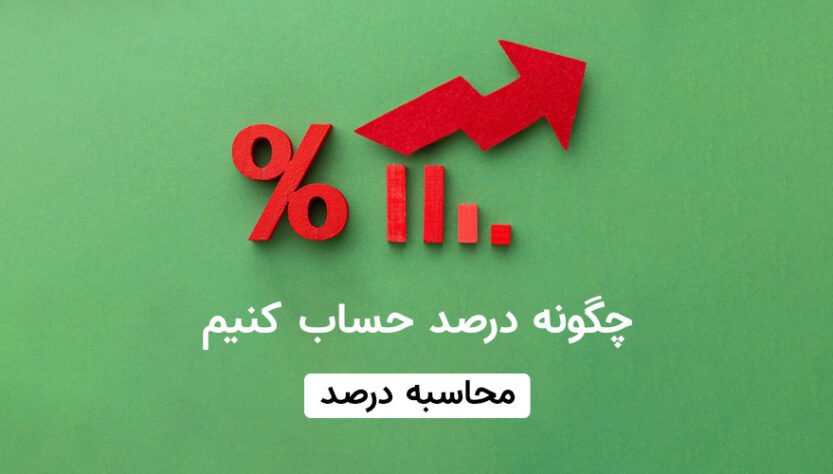How to calculate percentages + training to calculate types of percentages
Percentage is actually a way to show progress, profit or ratio between two numbers. The percentage is unitless and one percent represents one unit out of one hundred units of the desired quantity. Percentage is widely used in different fields and matters and it is used many times in different places. As a standard, the percentage should be a number between 0 and 100, but in practice we see percentages above 100. In this article from the site How We will learn how to calculate percentages by citing various examples. So join us.
Learning how to calculate percentages:

Calculating percentages is a simple task, but be careful that calculating percentages in a general way cannot cover all its applications. For example, calculating the percentage of tests including a negative score has a different algorithm than calculating the percentage of profit and loss or the discount of a product. In this section, we will learn how to calculate percentages in different activities.
1- Calculating the percentage of the test taking into account the negative score:
One of the most frequent questions of students and candidates for the entrance exam is how to calculate the percentage in the tests. To calculate the percentage in the tests, it is enough to use the following formula.
N = number of questions
T = correct tests
F = false tests
Percent = percentage
Percent = (3T-F)/3N
For example, let’s say you’ve taken a twenty test. So the number of exam questions, N is equal to 20. If you answered 12 questions correctly (T=12) and answered 3 questions incorrectly (F=3), your exam percentage will be 55% according to the above relationship.
(12*3-3)/(3*20) = 55
Using the above formula, you can easily calculate the percentage of all your tests.
2- Calculation of profit and loss percentage:
Calculating profit and loss percentage is one of the most practical percentage tasks. To calculate the percentage of profit and loss, it is enough to use the following formula.
P0 = initial capital
P1 = secondary capital
Percent = percentage
Percent = (P1-P0)/P0
For example, if your initial capital or the amount you spent to buy goods or financial instruments is 100 thousand Tomans (P0 = 100) and with the passage of time your current capital or the value of purchased goods and financial instruments equals 140 thousand Tomans (P1 = 140), your profit will be equal to 40%.
(100-140)/100 = 40%
Similarly, if your capital or the value of goods or financial instruments purchased at the present time is equal to 80 thousand Tomans (P1 = 80), your loss is equal to 20%.
(80-100)/100 = -20%
If the number obtained from the above formula becomes positive, you have made a profit and if the resulting number becomes negative, you have made a loss.
3- Calculation of discount percentage:
Calculating the discount percentage is one of the mathematical operations that many people have trouble calculating. To calculate the discount percentage of anything, it is enough to use the following formula.
P = previous price
D = discount percentage
N = price after discount
P*(1-D)=N
For example, suppose that the price of a product before the discount is 120 Tomans and this product is subject to a 25% discount. According to the above formula, the price of this product will be 90 Tomans after applying the discount. Also, if you have the price before the discount and after the discount, to calculate the discount percentage, it is enough to divide the price after the discount by the price before the discount. For example, if the price of a product after the discount is 50 Tomans and the price before the discount is 80 Tomans, the discount percentage of this product is equal to 37.5%.
4- Calculating the percentage with a calculator:

To calculate the percentage with the calculator, it is enough to enter the desired number in the calculator. Then press the multiplication key and enter your desired percentage and finally tap on the percentage key to calculate the percentage of your desired number.
For example, if you want to calculate 20 percent of 145, just enter 145 and then multiply it by 20 and finally tap on the percentage key. The resulting number will be equal to 29.
Also, in order to manually calculate this value, it is enough to write the desired number and multiply it by the desired percentage and divide the resulting number by 100.
5- Calculating a percentage of a number:
To calculate a percentage of any number or quantity, it is enough to multiply the desired percentage by the desired number. First, write down the percentage you want as a fraction. Then multiply it by the number you want. For example, if you want to find 60% of the number 150, just write down 60% as 100 divided by 60 and multiply it by 150.
(60/100)*150 = 90
Conclusion:
Calculating the percentage is very easy, and in order for its concept to fit you more and better, it is enough to pay attention to the true meaning of the percentage. Each percentage means 1 unit out of 100 units. 100% of a quantity will also be equal to that quantity itself. For example, 100 percent of 40 tables is equal to the same 40 tables.
In this article, we taught you how to calculate percentages and introduced formulas for calculating percentages. It is enough to use the formulas of the relevant section depending on your needs and calculate your desired percentage.
